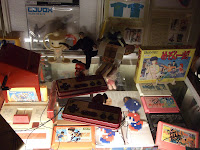 Up a flight of stairs in a bland Shinjuku building is a Shrine to nerdy teenage living in the 80's, a Temple of Famicom, manga and anime figurines. It is called 8 Bit Cafe.
Up a flight of stairs in a bland Shinjuku building is a Shrine to nerdy teenage living in the 80's, a Temple of Famicom, manga and anime figurines. It is called 8 Bit Cafe.Well, actually, it's just a cafe, but a remarkable one. 8 Bit Cafe's website says its concept is “recreating that after-school hangout” you had when you were a kid—and the kid they have in mind is the 80's Japanese boy who spent too much time battling friends on Nintendo, or, on Mondays, lying around flipping through the latest issue of Shonen Jump. But this hangout is more stylish than any playroom ever was—the walls are painted white in the trendy Tokyo cafe fashion, and on the wall are artsy, framed portraits of cartoon characters. Scattered everywhere are old Famicom consoles and cartridges, manga books and toys and figurines.
 What blows my mind is that there was someone for whom those teenage days of game-playing and manga-reading at home were so important that the person decided to open up a business to glorify them. I played the Nintendo too—but was there really that much there? Is this a hangout for people who don't want to grow up (and if so, why don't they want to)? The cafe weirded me out a bit (the same way a lot of the Akiba places and the whole Cult of Famicom—a big thing among some of the piko piko groups—weird me out). But the concept is novel, and I suppose that's a necessary thing for a cafe...
What blows my mind is that there was someone for whom those teenage days of game-playing and manga-reading at home were so important that the person decided to open up a business to glorify them. I played the Nintendo too—but was there really that much there? Is this a hangout for people who don't want to grow up (and if so, why don't they want to)? The cafe weirded me out a bit (the same way a lot of the Akiba places and the whole Cult of Famicom—a big thing among some of the piko piko groups—weird me out). But the concept is novel, and I suppose that's a necessary thing for a cafe...Anyway, I was there to see Little Lounge Little Twinkle, who put on a brilliant solo show. They fit in well at the 8 Bit Cafe: many of their songs have a playful, kid's music feel (one song uses a strawberry-shaped music sampler toy, for example), which shares something with the cafe's concept. But, still, behind all their fun little songs are solid arrangements by classically-trained musicians (I wrote more about them here), and their kiddy songs aren't very Famicom-like and more like handmade, wooden European toys, if that makes any sense at all...


 ***
***



 Do Buddhism and rock music mix?
Do Buddhism and rock music mix?
 ***
*** After the event I moved on to the town of Koenji (also originally a name of a Buddhist temple) to see
After the event I moved on to the town of Koenji (also originally a name of a Buddhist temple) to see